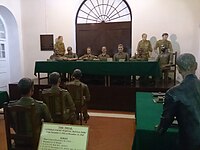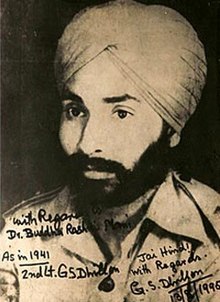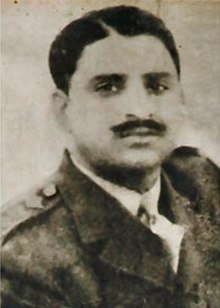Indian National Army trials

The Indian National Army trials (also known as the INA trials and the Red Fort trials) was the British Indian trial by court-martial of a number of officers of the Indian National Army (INA) between November 1945 and May 1946, on various charges of treason, torture, murder and abetment to murder, during the Second World War.
Jawaharlal Nehru in Poona had announced that Congress would stand responsible for the trials. The committee formed for the defence of INA soldiers was formed by Congress Working Committee. It included Jawaharlal Nehru, Bhulabhai Desai, Asaf Ali, Tej Bahadur Sapru, Kailash Nath Katju and others.[1]
Initially, over 7,600 members of INA were set for trial but due to difficulty in proving their crimes the number of trials were significantly reduced.
The trials covered arguments based on



Indian National Army
At the outbreak of
At the conclusion of the
Early trials
By 1943 and 1944,
With the release of Sarat Chandra Bose on 14 September 1945, the trials began to take an organized form.[5]
Public trials

However, the number of INA troops captured by Commonwealth forces by the end of the Burma Campaign made it necessary to take a selective policy to charge those accused of the worst allegations. The first of these was the joint trial of Shah Nawaz Khan, Prem Sahgal and Gurbaksh Singh Dhillon, followed by the trials of Abdul Rashid, Shinghara Singh, Fateh Khan, Captain Malik Munawar Khan Awan, Captain Allah Yar Khan, and several other commissioned officers of the INA. The decision was made to hold a public trial, as opposed to the earlier trials, and given the political importance and significance of the trials, the decision was made to hold these at the Red Fort. Also, due to the complexity of the case, the provision was made under the Indian Army Act rule 82(a) for counsels to appear for defense and prosecution. The then Advocate General of India, Sir Naushirwan P Engineer was appointed the counsel for Prosecution.
INA Defence committee
The Indian National Congress made the release of the three defendants an important political issue during the agitation for independence of 1945–6. The INA Defence Committee was a committee established by the Indian National Congress in 1945 to defend those officers of the Indian National Army who were to be charged during the INA trials. Additional responsibilities of the committee also came to be the co-ordination of information on INA troops held captive, as well as arranging for relief for troops after the war. The committee declared the formation of the Congress' defence team for the INA and included Jawaharlal Nehru, Tej Bahadur Sapru, Bhulabhai Desai, R.B. Badri Das, Asaf Ali, Kanwar Sir Dalip Singh, Kailash Nath Katju, Bakshi Sir Tek Chand, P.N. Sen, Inder Deo Dua, Shiv Kumar Shastri, Ranbeer Chand Soni, Rajinder Narayan, Sultan Yar Khan, Narayan Andley and J.K. Khanna.[1]
The first trial
The first trial, that of Shah Nawaz Khan, Gurubaksh Singh Dhillon and Prem Sahgal was held between November and December 1945 against the backdrop of general elections in India with the Attorney General of India, Noshirwan P. Engineer as the chief prosecutor and two dozen counsel for the defense, led by Sir Tej Bahadur Sapru and fronted by Lt. Col Horilal Varma Bar At Law[6] All three of the accused were charged with "waging war against the king contrary to section 121 of the Indian Penal Code". In addition, charges of murder were leveled against Dhillon and of abetment to murder against Khan and Sahgal. The defendants were Punjabis who came from three different religions – one Hindu, one Sikh, and one Muslim – but all three elected to be defended by the defense committee set up by the Indian National Congress.[6]
Second trial
These were the trials of Captain Abdul Rashid, Captain Shinghara Singh Mann, Captain Munawar Khan, Captain Allah Yar Khan, Lieutenant Fateh Khan and some other officers. Shangara Singh was awarded the Sardar-e-Jung, the second-highest decoration bestowed by Azad Hind government for valour in combat, and the Vir-e-Hind medal. Subhas Chandra Bose himself gave Singh Mann his medals in Rangoon. He was captured by the British and held in a prison in Multan from January 1945 to February 1946. After his release, he returned to his family in the Punjab. In 1959, he settled in Vadodara, Gujarat, where he remained as of 2001. He died aged 113. Though Captain Allah Yar Khan and few of his coompanions were listed as POWs but in fact they escaped into jungle surrounding Singapore, fearing torture at the hands of the Japanese soldiers. They survived in jungle hunting and stalking on Japanese supply until October 1943 when they joined the second INA raised under Subhas Chandra Bose. At the time of trial, Captain Khan was under treatment at India-based General Hospital in Bangalore. In the wake of unrest over the charges of treason and glorification of INA soldiers in the first trial, the charges of treason was dropped. However, these officers were cashiered from army with rank reduction from the date of grant of emergency commission. The site of trial was also moved from the Red Fort to an adjoining building. [7]
Consequences of the trials
Beyond the concurrent campaigns of noncooperation and nonviolent protest, this spread to include mutinies and wavering support within the British Indian Army. This movement marked the last major campaign in which the forces of the Congress and the Muslim League aligned together; the Congress
During the trial,
Another Army mutiny took place at Jabalpur during the last week of February 1946, soon after the Navy mutiny at Bombay, which were both suppressed. It lasted about one week. After the mutiny, about 45 persons were tried by court martial. 41 were sentenced to varying terms of imprisonment or dismissal. In addition, a large number were discharged on administrative grounds. While the participants of the Naval Mutiny were given the freedom fighters' pension, the Jabalpur mutineers got nothing. They even lost their service pension.
Most of the INA soldiers were set free after cashiering and forfeiture of pay and allowance.[8]
After the war ended, the story of the INA and the Free India Legion was seen as so inflammatory that, fearing mass revolts and uprisings—not just in India, but across its empire—the British government forbade the BBC from broadcasting their story.[12] However, the stories of the trials at the Red Fort filtered through. Newspapers reported at the time of the trials that some of the INA soldiers held at Red Fort had been executed,[13] which only succeeded in causing further protests.
In popular culture
The 2017 period drama film Raag Desh is based on the INA trials.
See also
- Indian National Army
- INA Defence Committee, the legal defence team for the INA formed by the Indian National Congress in 1945.
- Prem Kumar Sahgal, defendants in the first INA trial.
- Malik Munawar Khan Awan, who commanded the 2nd INA Guerrilla Battalion during the Battle of Imphal.
- Habib-ur-Rehman, Subhas Chandra Bose's chief of staff.
- Lakshmi Sahgal, who commanded the Rani of Jhansi Regiment and was also the minister in charge of women's affairs in the Azad Hind government.
- Indian National Congress
References
- ^ ISBN 978-81-269-0316-0.
- ISBN 978-0-14-190980-6.
- S2CID 191697854.
- ^ Stephen P. Cohen "Subhas Chandra Bose and the Indian National Army" Pacific Affairs Vol. 36, No. 4 (Winter, 1963) pp 411-429
- ISBN 978-81-321-0205-2. Retrieved 4 June 2023.
- ^ JSTOR 1090088.
- ^ Sharma, Ram Rakesh (1949): Azad Hind Fouj
- ^ Nirad C. Chaudhuri "Subhas Chandra Bose-His Legacy and Legend" Pacific Affairs Vol. 26, No. 4 (December 1953), pp. 349-350
- ^ "Historical Journey of the Indian National Army". National Archive of Singapore.
{{cite web}}: Missing or empty|url=(help) - ^ Lebra, Joyce C., Jungle Alliance: Japan and the Indian National Army, Singapore, Asia Pacific Library
- ^ Borra R. Subhash Chandra Bose. Journal of Historical Review, 3, no. 4 (Winter 1982), pp. 407-439
- ^ Hitler's Secret Indian Army Last Section: "Mutinies" URL accessed on 8 August 2006
- ^ "Many I.N.A. men already executed, Lucknow" Archived 2007-08-09 at the Wayback Machine. The Hindustan Times, 2 November 1945. URL accessed 11 August 2006

